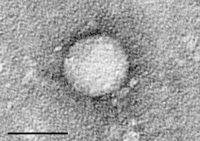
Photo from wikipedia
BACKGROUND & AIMS Direct-acting antiviral therapies (DAA) are an important tool for hepatitis C virus (HCV) elimination. However, reinfection among people who inject drugs (PWID) may hamper elimination targets. Therefore,… Click to show full abstract
BACKGROUND & AIMS Direct-acting antiviral therapies (DAA) are an important tool for hepatitis C virus (HCV) elimination. However, reinfection among people who inject drugs (PWID) may hamper elimination targets. Therefore, we estimated HCV reinfection rates among DAA-treated individuals, including PWID. METHODS We analyzed data from the British Columbia Hepatitis Testers Cohort which included ∼1.7 million individuals screened for HCV in British Columbia, Canada. We followed HCV-infected individuals treated with DAAs who achieved a sustained virologic response (SVR) and had ≥1 subsequent HCV RNA measurement to April 22nd, 2018. Reinfection was defined as a positive RNA measurement after SVR. PWID were identified using a validated algorithm and classified based on recent (<3 years) or former (≥3 years before SVR) use. Crude reinfection rates per 100 person-years (PYs) were calculated. Poisson regression was used to model adjusted incidence rate ratios (IRRs) and 95% CIs. RESULTS Of 4,114 individuals who met the inclusion criteria, most were male (n = 2,692, 65%), born before 1965 (n = 3,411, 83%) and were either recent (n = 875, 21%) or former PWID (n = 1,793, 44%). Opioid-agonist therapy (OAT) was received by 19% of PWID. We identified 40 reinfections during 2,767 PYs. Reinfection rates were higher among recent (3.1/100 PYs; IRR 6.7; 95% CI 1.9-23.5) and former PWID (1.4/100 PYs; IRR 3.7; 95% CI 1.1-12.9) than non-PWID (0.3/100 PYs). Among recent PWID, reinfection rates were higher among individuals born after 1975 (10.2/100 PYs) and those co-infected with HIV (5.7/100 PYs). Only one PWID receiving daily OAT developed reinfection. CONCLUSIONS Population-level reinfection rates remain elevated after DAA therapy among PWID because of ongoing exposure risk. Engagement of PWID in harm-reduction and support services is needed to prevent reinfections. LAY SUMMARY Direct-acting antivirals are an effective tool for the treatment of hepatitis C virus, enabling the elimination of the virus. However, some patients who have been successfully treated with direct-acting antivirals are at risk of reinfection. Our findings showed that the risk of reinfection was highest among people with recent injection drug use. Among people who inject drugs, daily use of opioid-agonist therapy was associated with a lower risk of reinfection.
Journal Title: Journal of hepatology
Year Published: 2018
Link to full text (if available)
Share on Social Media: Sign Up to like & get
recommendations!